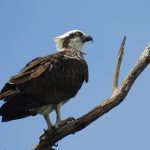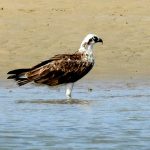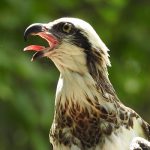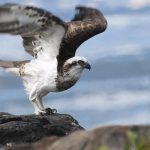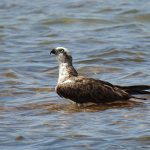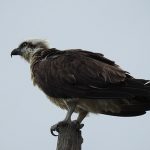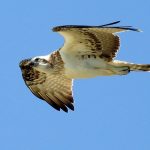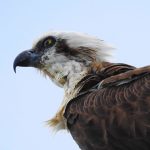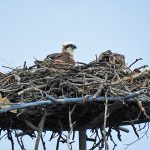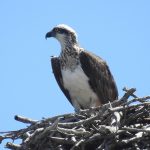OSPREY
The Master Fisher of the Skies
The Osprey stands as one of nature’s most remarkable raptors, renowned globally for its distinctive beauty and extraordinary fishing abilities. Known variously as the sea hawk, river hawk, or fish hawk, the Osprey embodies adaptability and ecological importance across nearly every continent. The presence and behaviours of these striking birds offer profound insights into the interconnectedness of aquatic habitats and the species that depend on them.
Appearance
The Osprey is easily distinguished by its sharp contrasts in colouring:
- Head, Chest, and Belly: Predominantly white, giving it a clean and bold profile.
- Upperparts: Deep chocolate-brown feathers covering the wings and back.
- Eyes and Beak: Vivid, forward-facing yellow eyes for precise targeting, and a hooked beak perfected for tearing flesh.
- Wingspan: Ranges from 150 to 180 cm, providing an expansive, powerful presence in the air.
- Feet and Talons: Ospreys have strong, specialised feet that are perfectly suited for gripping slippery prey such as fish. One of their most remarkable adaptations is the ability to rotate the fourth toe so that it can oppose the first toe, while the second and third toes remain aligned together. This configuration—known as zygodactylous feet—enables the Osprey to securely grasp fish using two toes at the front and two at the back, creating a much stronger hold. This adaptation greatly enhances their ability to catch and carry fish efficiently, even when their prey is struggling and wet.
Sensory Experience
Imagine observing an Osprey perched atop a tall tree or utility pole, the wind ruffling its feathers. As it glides above a shimmering body of water, its piercing gaze scans for movement below. With wings broad and silent, it hovers, then swoops with incredible precision, talons outstretched, breaking the water’s surface in a spectacular spray—a scene that resonates through sight and sound, invoking awe in all who witness it.
Where Ospreys Live
Ospreys are one of the most cosmopolitan birds of prey:
- Global Range: Present on every continent except Antarctica.
- Habitat: Inhabit freshwater lakes, rivers, coastal estuaries, and occasionally large reservoirs—anywhere with abundant fish and suitable nesting sites.
- Nesting Preferences: Prefer tall structures—trees, cliffs, or even human-made platforms. Due to their adaptability, they have thrived in regions touched by human activity, constructing nests on power poles and navigation markers.
Breeding and Migration
- Nest Building: Both male and female contribute to building large, conspicuous stick nests, often returning to the same site for several breeding seasons. These nests are visible landmarks in the landscape.
- Seasonal Movement: Many populations undertake long migratory journeys, travelling thousands of kilometres between breeding and wintering grounds. In Australia, for example, the eastern Osprey is generally sedentary, while elsewhere, migratory patterns are dictated by climate and food availability.
Diet
- Primary Food: Fish make up over 99% of the Osprey’s diet.
- Hunting Strategy: Ospreys are master anglers. They float or hover up to 30 metres above water, surveying for prey. Once a fish is spotted, the bird plunges feet-first, breaking the surface in a dramatic burst of energy.
- Physical Adaptations:
- Reversible outer toe allows talons to grasp fish with two toes in front and two behind, providing formidable grip.
- Spiny pads on the feet prevent slippery fish from escaping.
- Nostrils close upon diving to prevent water intake.
Ecological Importance
Ospreys are apex predators within their aquatic habitats. Their presence indicates the health of water bodies, as they require clean waters and abundant fish populations to thrive.
- Predator-Prey Dynamics: Help regulate fish populations, keeping ecosystems balanced.
- Bioindicators: Sensitive to environmental contamination, their health is often a reflection of ecosystem integrity.
Conservation and Threats
Ospreys, although adaptable, face a range of threats:
- Human Disturbance: Construction, recreational boating, and development near nesting sites can lead to nest abandonment or reduced breeding success.
- Environmental Contaminants: Chemicals like pesticides and industrial pollutants (notably DDT in the mid-20th century) can accumulate in fish and affect Ospreys’ reproductive health, causing eggshell thinning and reduced hatch rates.
- Habitat Loss: Draining of wetlands and deforestation can remove key nesting and hunting grounds.
Conservation Measures
Efforts to protect Ospreys include:
- Reducing Human Disturbance: Establishing buffer zones around nesting sites.
- Legislation: Enacting policies to limit pesticide use and promote clean waterways.
- Artificial Nest Platforms: Providing safe alternatives for nesting in developed areas.
- Public Engagement: Educational programmes raise awareness of the Osprey’s needs and foster community stewardship.
Cultural Significance and Human Connection
Ospreys have long inspired people across cultures, symbolising power, vision, and freedom in myths and literature. In modern times, their spectacular fishing technique and striking appearance have made them icons among birdwatchers and nature photographers. Observing these birds encourages a deep sense of wonder and a greater appreciation for the complexity and fragility of aquatic life.
A Story of Adaptation, Wonder, and Responsibility
The Osprey is not just a symbol of wild beauty and skill, but a sentinel for the wellbeing of aquatic environments. Its lifecycle, from patient hunter to caring parent, is a story interwoven with the health of wetlands, rivers, and coastlines. By supporting the conservation of Ospreys and their habitats, we contribute to the balance and diversity of ecosystems that benefit all life—including our own.
Stewardship of these magnificent birds invites us to reflect on the profound connections between water, land, wildlife, and people, ensuring that future generations can look up and see the master fisher at work above shining waters.
References
- Debus, S. J. S. (2012). Birds of Prey of Australia: A Field Guide.
- Poole, A. F. (2019). Ospreys: The Revival of a Global Raptor.
- International Union for Conservation of Nature. Osprey (Pandion haliaetus) Red List Assessment.
- BirdLife Australia. Species factsheet: Osprey.


